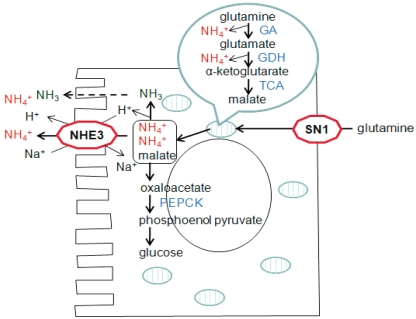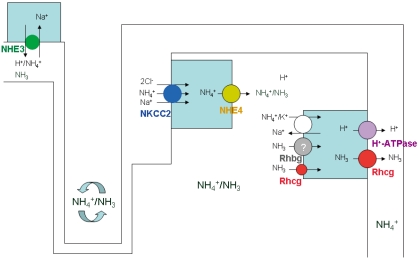Electrolyte Blood Press.
2011 Dec;9(2):45-49. 10.5049/EBP.2011.9.2.45.
Mechanisms of the Effects of Acidosis and Hypokalemia on Renal Ammonia Metabolism
- Affiliations
-
- 1Department of Anatomy, Ewha Womans University School of Medicine, Seoul, Korea. khhan@ewha.ac.kr
- KMID: 2168383
- DOI: http://doi.org/10.5049/EBP.2011.9.2.45
Abstract
- Renal ammonia metabolism is the predominant component of net acid excretion and new bicarbonate generation. Renal ammonia metabolism is regulated by acid-base balance. Both acute and chronic acid loads enhance ammonia production in the proximal tubule and secretion into the urine. In contrast, alkalosis reduces ammoniagenesis. Hypokalemia is a common electrolyte disorder that significantly increases renal ammonia production and excretion, despite causing metabolic alkalosis. Although the net effects of hypokalemia are similar to metabolic acidosis, molecular mechanisms of renal ammonia production and transport have not been well understood. This mini review summarizes recent findings regarding renal ammonia metabolism in response to chronic hypokalemia.
Keyword
Figure
Reference
-
1. Alper SL, Natale J, Gluck S, Lodish HF, Brown D. Subtypes of intercalated cells in rat kidney collecting duct defined by antibodies against erythroid band 3 and renal vacuolar H+-ATPase. Proc Natl Acad Sci U S A. 1989; 86:5429–5433. PMID: 2526338.2. Kim J, Kim YH, Cha JH, Tisher CC, Madsen KM. Intercalated cell subtypes in connecting tubule and cortical collecting duct of rat and mouse. J Am Soc Nephrol. 1999; 10:1–12. PMID: 9890303.
Article3. Knepper MA, Packer R, Good DW. Ammonium transport in the kidney. Physiol Rev. 1989; 69:179–249. PMID: 2643123.
Article4. Weiner ID. The Rh gene family and renal ammonium transport. Curr Opin Nephrol Hypertens. 2004; 13:533–540. PMID: 15300160.
Article5. Weiner ID, Verlander JW. Role of NH3 and NH4+ transporters in renal acid-base transport. Am J Physiol Renal Physiol. 2011; 300:F11–F23. PMID: 21048022.6. Solbu TT, Boulland JL, Zahid W, et al. Induction and targeting of the glutamine transporter SN1 to the basolateral membranes of cortical kidney tubule cells during chronic metabolic acidosis suggest a role in pH regulation. J Am Soc Nephrol. 2005; 16:869–877. PMID: 15716335.
Article7. Tong J, Harrison G, Curthoys NP. The effect of metabolic acidosis on the synthesis and turnover of rat renal phosphate-dependent glutaminase. Biochem J. 1986; 233:139–144. PMID: 3954723.
Article8. Abu Hossain S, Chaudhry FA, Zahedi K, Siddiqui F, Amlal H. Cellular and molecular basis of increased ammoniagenesis in potassium deprivation. Am J Physiol Renal Physiol. 2011; 301:F969–F978. PMID: 21795646.
Article9. Alleyne GA, Scullard GH. Renal metabolic response to acid base changes. I. Enzymatic control of ammoniagenesis in the rat. J Clin Invest. 1969; 48:364–370. PMID: 4303457.10. Vinay P, Allignet E, Pichette C, Watford M, Lemieux G, Gougoux A. Changes in renal metabolite profile and ammoniagenesis during acute and chronic metabolic acidosis in dog and rat. Kidney Int. 1980; 17:312–325. PMID: 7401451.
Article11. Attmane-Elakeb A, Mount DB, Sibella V, Vernimmen C, Hebert SC, Bichara M. Stimulation by in vivo and in vitro metabolic acidosis of expression of rBSC-1, the Na+-K+(NH4+)-2Cl- cotransporter of the rat medullary thick ascending limb. J Biol Chem. 1998; 273:33681–33691. PMID: 9837954.12. Bourgeois S, Meer LV, Wootla B, et al. NHE4 is critical for the renal handling of ammonia in rodents. J Clin Invest. 2010; 120:1895–1904. PMID: 20484819.
Article13. Wagner CA, Devuyst O, Belge H, Bourgeois S, Houillier P. The rhesus protein RhCG: a new perspective in ammonium transport and distal urinary acidification. Kidney Int. 2011; 79:154–161. PMID: 20927037.
Article14. Eladari D, Cheval L, Quentin F, et al. Expression of RhCG, a new putative NH3/NH4+ transporter, along the rat nephron. J Am Soc Nephrol. 2002; 13:1999–2008. PMID: 12138130.15. Han KH, Croker BP, Clapp WL, et al. Expression of the ammonia transporter, rh C glycoprotein, in normal and neoplastic human kidney. J Am Soc Nephrol. 2006; 17:2670–2679. PMID: 16928804.
Article16. Han KH, Lee HW, Handlogten ME, et al. Effect of hypokalemia on renal expression of the ammonia transporter family members, Rh B Glycoprotein and Rh C Glycoprotein, in the rat kidney. Am J Physiol Renal Physiol. 2011; 301:F823–F832. PMID: 21753075.
Article17. Verlander JW, Miller RT, Frank AE, Royaux IE, Kim YH, Weiner ID. Localization of the ammonium transporter proteins RhBG and RhCG in mouse kidney. Am J Physiol Renal Physiol. 2003; 284:F323–F337. PMID: 12388412.18. Ambuhl PM, Amemiya M, Danczkay M, et al. Chronic metabolic acidosis increases NHE3 protein abundance in rat kidney. Am J Physiol. 1996; 271:F917–F925. PMID: 8898023.
Article19. Seshadri RM, Klein JD, Kozlowski S, et al. Renal expression of the ammonia transporters, Rhbg and Rhcg, in response to chronic metabolic acidosis. Am J Physiol Renal Physiol. 2006; 290:F397–F408. PMID: 16144966.
Article20. Seshadri RM, Klein JD, Smith T, et al. Changes in subcellular distribution of the ammonia transporter, Rhcg, in response to chronic metabolic acidosis. Am J Physiol Renal Physiol. 2006; 290:F1443–F1452. PMID: 16434569.
Article21. Biver S, Belge H, Bourgeois S, et al. A role for Rhesus factor Rhcg in renal ammonium excretion and male fertility. Nature. 2008; 456:339–343. PMID: 19020613.
Article22. Lee HW, Verlander JW, Bishop JM, Igarashi P, Handlogten ME, Weiner ID. Collecting duct-specific Rh C glycoprotein deletion alters basal and acidosis-stimulated renal ammonia excretion. Am J Physiol Renal Physiol. 2009; 296:F1364–F1375. PMID: 19321595.
Article23. Karet FE. Mechanisms in hyperkalemic renal tubular acidosis. J Am Soc Nephrol. 2009; 20:251–254. PMID: 19193780.24. Tannen RL. Effect of potassium on renal acidification and acid-base homeostasis. Semin Nephrol. 1987; 7:263–273. PMID: 2825318.25. Tizianello A, Garibotto G, Robaudo C, et al. Renal ammoniagenesis in humans with chronic potassium depletion. Kidney Int. 1991; 40:772–778. PMID: 1745029.
Article26. Elkjaer ML, Kwon TH, Wang W, et al. Altered expression of renal NHE3, TSC, BSC-1, and ENaC subunits in potassium-depleted rats. Am J Physiol Renal Physiol. 2002; 283:F1376–F1388. PMID: 12388387.
- Full Text Links
- Actions
-
Cited
- CITED
-
- Close
- Share
- Similar articles
-
- A Case of Primary Sjiigren's Syndrome with Hypokalemic Paralysis and Renal Tubular Acidosis
- Distal Renal Tubular Acidosis with Nephrocalcinosis in a Patient with Primary Sjogren's Syndrome
- A case of Fanconi syndrome
- Two Cases of Distal Renal Tubular Acidosis accompanied by Sjogren's Syndrome
- Incomplete Distal Renal Tubular Acidosis with Nephrocalcinosis



